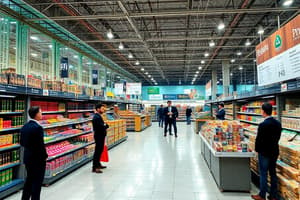Podcast
Questions and Answers
In a perfectly competitive industry, what type of market power does each firm have?
In a perfectly competitive industry, what type of market power does each firm have?
- Price-maker
- Half of the total industry output
- Differentiated product producer
- Standardized product producer (correct)
What is the condition for a perfectly competitive firm to earn a profit and continue producing the profit-maximizing quantity of output in the short run?
What is the condition for a perfectly competitive firm to earn a profit and continue producing the profit-maximizing quantity of output in the short run?
- Greater than average variable cost, but less than average total cost (correct)
- Less than marginal cost
- Greater than average total cost
- Greater than average fixed cost
What does a firm's total output times the price at which it sells that output represent?
What does a firm's total output times the price at which it sells that output represent?
- Net revenue
- Marginal revenue
- Average revenue
- Total revenue (correct)
What is the difference between total revenue and total cost known as?
What is the difference between total revenue and total cost known as?
Under perfect competition, how does a firm determine its output level based on the market price?
Under perfect competition, how does a firm determine its output level based on the market price?
What is marginal revenue?
What is marginal revenue?
In a perfectly competitive market, a firm is considered a price-taker because:
In a perfectly competitive market, a firm is considered a price-taker because:
If a perfectly competitive firm is producing at the profit-maximizing level, what can be said about the relationship between marginal cost (MC) and marginal revenue (MR)?
If a perfectly competitive firm is producing at the profit-maximizing level, what can be said about the relationship between marginal cost (MC) and marginal revenue (MR)?
If a perfectly competitive firm is experiencing losses in the short run, it should:
If a perfectly competitive firm is experiencing losses in the short run, it should:
What happens to a perfectly competitive firm's total revenue when it sells one more unit of output?
What happens to a perfectly competitive firm's total revenue when it sells one more unit of output?
Which scenario best describes a perfectly competitive market structure?
Which scenario best describes a perfectly competitive market structure?
If a perfectly competitive firm is operating where price (P) is greater than marginal cost (MC), what should the firm do to maximize profit?
If a perfectly competitive firm is operating where price (P) is greater than marginal cost (MC), what should the firm do to maximize profit?
What is the relationship between the marginal product of a variable input and the total product curve?
What is the relationship between the marginal product of a variable input and the total product curve?
What is the marginal product of the second worker based on the given data in the table?
What is the marginal product of the second worker based on the given data in the table?
Which of the following is a fixed input for the production function at a deli?
Which of the following is a fixed input for the production function at a deli?
What is the marginal product of the fifth worker based on the given data in the table?
What is the marginal product of the fifth worker based on the given data in the table?
What is the condition for a perfectly competitive firm to earn a profit and continue producing the profit-maximizing quantity of output in the short run?
What is the condition for a perfectly competitive firm to earn a profit and continue producing the profit-maximizing quantity of output in the short run?
What does a firm's total output times the price at which it sells that output represent?
What does a firm's total output times the price at which it sells that output represent?
Flashcards are hidden until you start studying
Study Notes
Perfect Competition and Production
- A firm's profit can be increased by decreasing the price, but only if it leads to an increase in sales that outweighs the decrease in price.
- A perfectly competitive firm will earn a profit and continue producing in the short run if the price is greater than average variable cost, but less than average total cost.
Characteristics of Perfect Competition
- In a perfectly competitive industry, each firm is a price-taker and produces a standardized product.
- Individual firms cannot alter the market price, even if they double their output.
- The market sets the price, and each firm can take it or leave it.
Revenue and Cost
- Total revenue is the firm's total output times the price at which it sells that output.
- The difference between total revenue and total cost is economic profit or loss.
- Marginal revenue is the change in total revenue resulting from the sale of one more unit of output.
Production and Cost
- The total product curve shows the relation between output and the quantity of a variable input for varying levels of the fixed input.
- If a firm increases production from 10 units to 11 units and the market price is $20 per unit, total revenue for 10 units is $200.
- Average fixed cost is total fixed cost divided by the number of units produced.
Labour and Production
- The total product of labour is the total output produced by a certain number of workers.
- The marginal product of labour is the change in total product resulting from the addition of one more worker.
- Fixed inputs in a production function are those that do not change with the level of production, such as the dining room in a deli.
Studying That Suits You
Use AI to generate personalized quizzes and flashcards to suit your learning preferences.




